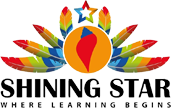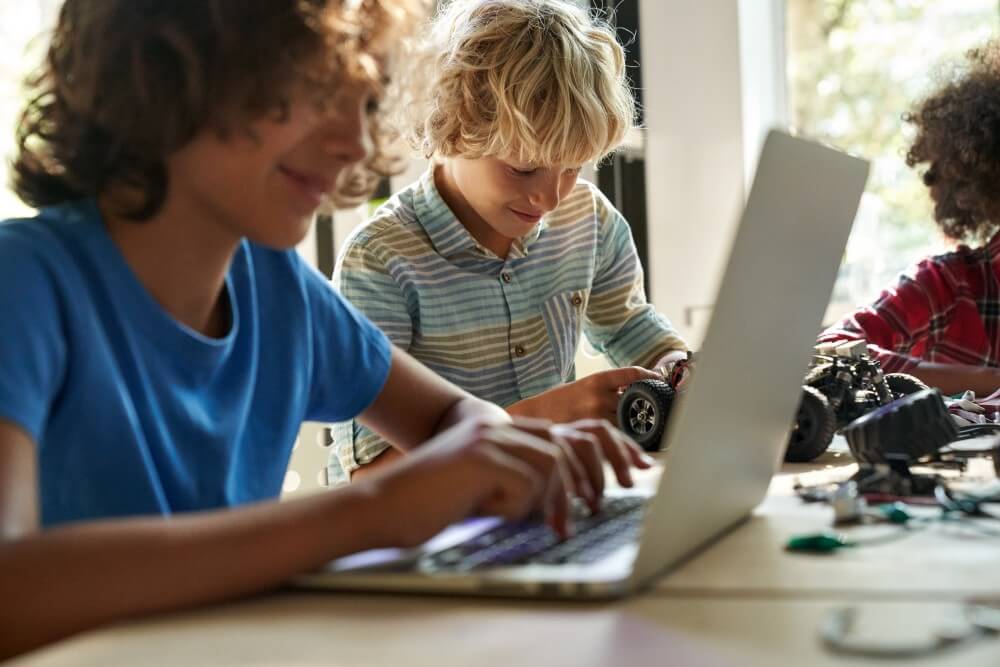Coding is emerging as a common skill today, quickly becoming a must-have tool, especially for young kids and teens, rather than being an esoteric skill acquired solely by tech professionals. Coding classes for kids and teens warm young minds to the world of programming in a fun, interactive, and engaging way. These courses also help instil critical thinking, problem-solving skills, creativity, and logical thinking among kids and teens, thus preparing them for great success in the future. The best part is that they cater to kids with zero knowledge right through intermediate levels.
Why Choose Our Coding Classes?
There are several ways in which our coding classes for teens and kids stand out from the rest:
- Active learning: We provide hands-on and project-based learning, whereby learners are actively engaged in the learning process.
- Skilled team: Our highly trained instructors are warm and nurturing to create an environment in which students are encouraged to ask questions and explore their curiosity.
- Latest Curriculum: The advancements in the tech world keep our curriculum relevant through this very same technological advancement.
- Flexibility: We offer convenient scheduling options online and offline to fit around busy family commitments.
Best Coding Languages for Kids & Teens
Getting the right coding language is the first key step for young learners. Some of the best (and most age-appropriate) languages to use with kids and teens include:
- Scratch: A visual programming language developed by MIT. Beginners can learn coding concepts in an interactive manner through stories, animations, and games.
- Python: An excellent language for beginners due to its simplicity and readability, this offers a firm grounding for more proficient programming in the future.
- JavaScript: Used mainly for front-end web development, JavaScript will introduce students into the whole world of front-end programming.
- Swift: Apple’s programming language, suited for teens who are interested in creating iOS apps.
Coding Courses We Offer for Kids & Teens
For Kids
- Code Basics with Scratch: Kids can learn to code with Scratch, a visual programming language developed by MIT. It is a fun and engaging way to develop coding basics through animations, games, and interactive stories.
- Animations and games: Our hands-on project-based classes help kids unleash their creative juices and bring ideas to life through coding.
- Introduction to Python: Entertaining and easy Python lessons for young learners. Kids can learn how to write simple programs and get introduced to the basics of this versatile programming language.
- Introduction to Game Development: Teens create simple animations and games using beginner-friendly tools and languages. Creativity is encouraged, and technical skills are developed along the way.
For Teens
Advance Python course: The contents of our complete Python course help teens hone their coding skills with professional-level Python. They study advanced concepts and applications for greater knowledge and preparation towards a tech career.
Benefits of Learning Coding at a Young Age
- Enhances problem-solving and critical thinking skills.
- Encourages creativity through game and app development.
- Boosts math and logic skills.
- Prepares kids for future careers in technology.
- Improves digital literacy and confidence in using technology.
How to Choose the Right Coding Course for Your Child
Choosing a coding school for your child could be a daunting task, given the many options available. Following are a few tips to help you make an informed decision.
- Assess Interest Areas and Skill Level:
- Discover what fields in technology and coding your child is excited about-making games, building websites, or programming robots?
- Recognize their Skill Level: Know if a child is a complete beginner or has some knowledge of coding.
- Look Out for Age-Appropriate Courses
- Make sure the course will be appropriate for your child’s age group. Young ones may prefer visual programming languages such as Scratch, while older kids and teens will be looking for advanced languages in this regard, namely Python or JavaScript.
- Course Contents and Learning Method
- Look out for courses that use practice and project-based learning. Interactive projects will engage the children and reinforce what they have learned.
- Check if the course covers what your child is keen on learning. Is it game development, web development, or application development?
- Quality instructors:
- Make sure a highly-experienced and knowledgeable tutor/teacher runs the course. The quality of instruction will affect a student’s progress.
- Flexibility and Accessibility.
- You will want to look into whether a course is available online, offline, or both. Online courses can be flexible, but offline classes provide a more structured learning environment.
- Find out about the schedule of courses according to the family routine. Some courses have live classes, while others offer the option to follow the courses at your own pace.
- Testimonials and Reviews.
- Read the reviews/testimonials from other parents/students to shed some light on the effectiveness of the course.
- Trial Classes/Free Resources
- Some coding platforms facilitate trial classes or free resources that help your child get a feel of whatever a course entails before you commit.
- Curriculum Updates
- Make sure the specific course gets regularly updated with regard to the technology and modern advancements.
- Support and community:
- Look for courses that provide complete support through discussion forums, mentorship programs, or programming communities where your child can interact with peers and instructors.
- Cost and value
- Compare course prices to see which offers the best value. While some of them may seem the most expensive on your list, they offer comprehensive instruction, personalized tutoring, or advanced language training.
By considering these factors, you can choose a coding course that fits your child’s needs, interests, and learning style best.
Online vs. Offline Coding Classes: Which is Better?
Online classes are flexible as students can learn anywhere and at their own pace, making use of interactive platforms and projects anytime they want. Offline classes maintain a structured learning environment where students interact face to face with each other; fostering community participation. Shining Star the leading training centre in Abu Dhabi allows students both online and offline options that cater to students’ preferences and learning styles.
Fun and Engaging Ways to Teach Kids Coding
- Gamify the Learning process through games and challenges.
- Encourage storytelling by letting children build their stories, animations, and games.
- Get them to learn coding with hands-on projects like building robots and digital art.
- Two heads are better than one, so divide the coding task into group projects and pair programming.
- Show how coding is used in math, science, and even art.
- Visual programming tools and platforms make learning intuitive.
- Kids can attend coding camps and workshops for structured, fun, and informative coding learning experiences.
- Introduce hands-on learning through kits like Raspberry Pi, Arduino, or LEGO Mindstorms.
- Bring coding closer to kids with their movie, games, and superheroes interests.
- Staging competitions or hackathons inspire and motivate young coders.
Top Coding Platforms for Kids & Teens
There are various coding platforms that are designed for kids and teens such as:
- Scratch: This is a visual programming platform that allows kids to create their own stories, games, and animation.
- Code.org: Coding lessons and projects interactive and suitable for all ages.
- Tynker: Provides courses and activities in coding for kids at any skill level.
- Codecademy: Beginner coding for ages 13 and above or teens and adults.
- Khan Academy: Offers extensive coding lessons and lots of practice.
How Our Coding Courses Work
Our coding courses for kids and teens are simple and easy. Here is how it works:
- Choose a Course: Browse what we offer and choose a course according to your child’s interests and skill level.
- Join a Live Class or an In-Class Session: Take live classes online or attend in-class session at one of our centers for convenience.
- Project-Based Learning: Hands-on projects and coding exercises will be beneficial in supporting learning.
- Interactive Lessons: Students get the chance to work with expert instructors for personalized guidance and support.
- Continuous Progress Check: Check monthly assessments to see how kids are doing with an assessment and feedback after each module.
How Coding Prepares Kids for Future Careers
Coding is an important component that prepares kids for a wide variety of careers. As technology continues to evolve, the requirement for skilled programmers/developers also continues to grow. Learning coding enables kids to enter fields such as software development, data science, artificial intelligence, cybersecurity, and more. Moreover, coding imbibes critical thinking, problem-solving, and creativity, which are valuable skills for any career.
Conclusion
Coding classes for kids and teens are an investment in their future. By learning to code, young learners develop valuable skills that will benefit them in numerous ways. Whether they pursue a career in technology or any other field, the problem-solving, creativity, and logical thinking skills gained through coding will serve them well. Join us at Shining Star and embark on an exciting coding journey with your child today!
FAQ
At what age can kids start learning coding?
Kids as young as 5-7 years old can start with block-based coding platforms like Scratch.
Do kids need any prior experience to join coding classes?
No, our coding classes for kids and teens are designed for beginners with no prior experience.
Which programming languages are best for kids and teens?
Scratch, Python, JavaScript, and MIT App Inventor are great for beginners.
Are online coding classes effective for kids?
Yes, online coding classes for teens provide flexibility, recorded sessions, and interactive learning.
What is the best way to teach coding to kids?
Using games, storytelling, and interactive projects makes coding fun and engaging.
What is the best way to teach coding to kids?
Using games, storytelling, and interactive projects makes coding fun and engaging.
How long does it take for a child to learn coding?
It depends on the child’s pace, but basics can be learned in a few months.
What are the benefits of coding for kids and teens?
Some of the benefits of coding courses for teens and kids include improving problem-solving, creativity, logical thinking, and future career prospects.
Which devices or software are required for coding classes?
You can use a laptop or tablet with access to Scratch, Python, or web-based coding tools.
What types of projects do kids work on in coding classes?
Some of the project types kids work in coding classes include animations, games, mobile apps, and basic websites.
Can coding help kids in their academic performance?
Absolutely. Coding can help kids as it enhances logical thinking, math skills, and problem-solving abilities.
Are these coding courses beginner-friendly?
Yes, our courses start with simple concepts and progress step by step.
What career opportunities can code open up for teens?
By learning coding, teens can open up their careers in software development, AI, game design, cybersecurity, and web development.

